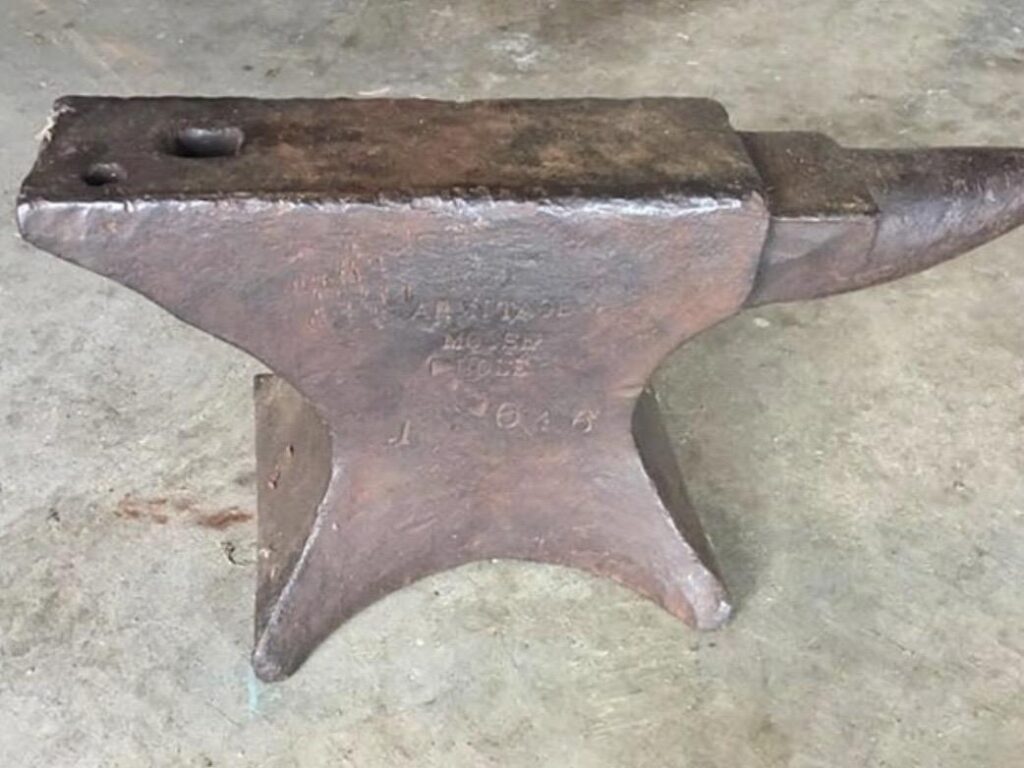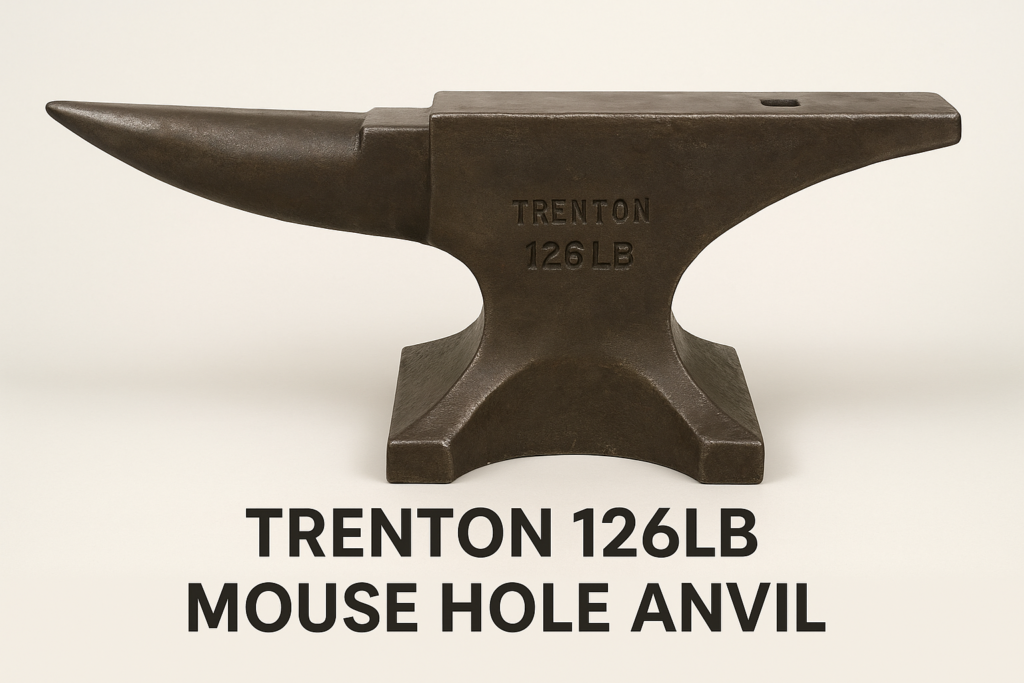Table of Contents
Trenton 126lb Mouse Hole Anvil is a name that gets many blacksmiths and collectors excited. It sounds cool, right? But what is it really? And why do people care so much about it? In this blog, we’re going to talk about this special anvil in simple words. You’ll learn what it is, how to spot a real one, and what makes it different from other anvils. Whether you’re new to blacksmithing or just love old tools, this post is for you!
Trenton 126lb Mouse Hole Anvil is not just a heavy piece of metal. It has history, value, and strong use in the blacksmith world. But here’s the thing—many people get confused by the name “Mouse Hole.” Some even mix up brands or think any old anvil with a hole is a Mouse Hole anvil. Don’t worry, we’ll break it all down step by step, so you’ll know exactly what to look for and what to avoid.
What Is a Trenton 126lb Mouse Hole Anvil? A Simple Guide for Beginners
If you love old tools or blacksmithing, you might hear the name “Trenton 126lb Mouse Hole Anvil.” But what does that even mean? Let’s break it down together. This anvil is a tool made of strong steel, and it weighs 126 pounds. People use it to shape hot metal, like when making horseshoes or tools. It’s heavy, but not too heavy, so it’s just right for lots of jobs.
Now, let’s talk about the name. “Trenton” is the brand. These anvils were made in America, and they are known to be strong and long-lasting. “Mouse Hole” sounds funny, right? But it comes from a place in England called Mousehole Forge. Some people mix the two names up, but they are actually different. Only some old anvils from England are true Mouse Hole anvils.
Some people call a Trenton anvil a “Mouse Hole” anvil by mistake. That’s because it might have a small hole underneath, just like the real Mouse Hole ones. But the hole isn’t what makes it special. What really matters is where and how the anvil was made. The Trenton 126lb version has special markings that can help us know if it’s real.
So, in simple words, this anvil is like a treasure for people who love blacksmithing. It’s not just a big metal block. It has history and value. Knowing what makes it real and how it’s different from other anvils is a smart step for anyone who wants to collect or use one. Don’t worry—we’ll show you how to spot the real one next!
The Real Story Behind the Trenton 126lb Mouse Hole Anvil Name
Some people get confused when they hear the name “Trenton 126lb Mouse Hole Anvil.” It sounds like one tool, but it’s really a mix of two famous anvil names. The truth is, Trenton and Mouse Hole are from different places and times. Trenton anvils were made in the USA. Mouse Hole anvils were made in England, many years earlier.
Trenton anvils were made by a company in Columbus, Ohio. This company used strong steel and smart designs to make anvils that blacksmiths loved. The 126-pound size was popular because it was easy to move but still heavy enough to do big jobs. These anvils always had clean shapes and strong faces that could handle hammer hits all day.
Mouse Hole anvils were made in a forge in Sheffield, England. They were some of the oldest anvils in the world. The name “Mouse Hole” came from the forge itself. These anvils usually had a rougher look, but they were very tough. They were made with older tools and methods, which made them different from Trenton anvils.
So, why do people mix up the names? Well, sometimes old Trenton anvils had a small hole in the base, just like the Mouse Hole ones. That’s where the mix-up starts. But if you look closely, you’ll see that the brands are different. One is American, and one is English. Knowing this can help you tell the difference and understand what you really have.
How to Tell If Your Trenton 126lb Mouse Hole Anvil Is the Real Deal

It can be tricky to know if your anvil is a real Trenton 126lb Mouse Hole Anvil or just looks like one. But don’t worry! There are easy ways to check. The most important thing is to look for the markings. Real Trenton anvils have stamps on the side. These stamps usually say “Trenton” and show a serial number.
The serial number is like a secret code. It tells you when the anvil was made. Most real Trenton anvils have this number on the front foot, under the horn. If your anvil has this, it’s a good sign! You can even use special charts online to find out what year your anvil was made. This is a fun way to learn more about your tool’s history.
Another thing to check is the shape. Trenton anvils are smooth and balanced. They have a long horn, a hardy hole (the square one), and a pritchel hole (the round one). The 126-pound size will feel heavy but not too big. If your anvil looks chunky or uneven, it might be a different brand.
Be careful! Some people change the markings on other anvils to make them look like Trenton anvils. This is not fair, and it can trick buyers. So always check all the details before you buy or sell one. A real Trenton 126lb Mouse Hole Anvil is special, and now you know how to spot it the smart way.
Top Signs to Spot a Genuine Trenton 126lb Anvil
If you want to be sure your anvil is a real Trenton 126lb Mouse Hole Anvil, you need to look at the small details. One of the first things to check is the Trenton stamp. It should be clearly marked on the side of the anvil, usually near the base. The stamp might look old or worn, but you should still be able to read “TRENTON” in big letters.
Another clue is the serial number. Most real Trenton anvils have a number stamped on the front foot, right under the horn. This number tells you when the anvil was made. If you don’t see a number there, it might not be a real Trenton. You can check that number using a Trenton serial number chart online. It’s like a birthday for your anvil!
You should also check the anvil’s shape and size. A Trenton 126lb anvil has a clean shape with a smooth face. The horn is long and not too sharp, and the body is well-balanced. It should feel solid and not wobbly. The bottom of the anvil might be hollow or flat, but it should always feel strong.
If someone is trying to sell you a “Trenton 126lb Mouse Hole Anvil,” make sure you check everything before buying. Look at the markings, test the shape, and double-check the number. It’s okay to ask questions too! A real Trenton is worth a lot, so don’t let anyone fool you. Be smart and look closely—you can do it!
Trenton 126lb Mouse Hole Anvil vs Other Anvils: What’s the Difference?

There are many kinds of anvils out there, and they all look kind of the same at first. But if you look closer, you’ll notice that the Trenton 126lb Mouse Hole Anvil stands out. It’s made with better steel, and the shape is very clean and smooth. The horn is round and easy to use, and the top face is flat and strong.
Other anvils might not be as smooth or balanced. Some are made with old or soft metal, so they don’t last as long. You might also find that cheaper anvils don’t have good rebound. That means when you hit them with a hammer, they don’t bounce back well. A real Trenton 126lb anvil gives a nice, solid “ring” sound and a strong bounce.
Another difference is the weight. Some anvils say they weigh 126 pounds, but they really don’t. A Trenton anvil is honest about its weight, and it feels just right for many blacksmithing jobs. It’s not too heavy to move, but it’s still strong enough to work on big metal pieces.
So if you’re trying to pick an anvil, remember that not all are the same. The Trenton 126lb Mouse Hole Anvil is special because it’s strong, shaped well, and trusted by many blacksmiths for over 100 years. If you want something that lasts and works great, Trenton is a name you can trust.
Conclusion
The Trenton 126lb Mouse Hole Anvil is not just an old tool—it’s a piece of history that still works great today. Many blacksmiths and collectors love it because it is strong, easy to use, and lasts a very long time. If you have one or want to buy one, it’s good to know how to tell if it’s real. Checking the stamp, serial number, and shape can help you feel sure.
Now you know what makes the Trenton 126lb Mouse Hole Anvil so special. It’s not just about the name—it’s about how it’s made and how well it works. If you ever get one, take good care of it, and it will take care of your metalwork. Thanks for reading, and happy hammering!
FAQs
Q: What is a Trenton 126lb Mouse Hole Anvil?
A: It’s a 126-pound anvil made by the Trenton company in the USA, often confused with English Mouse Hole anvils.
Q: How can I tell if my Trenton anvil is real?
A: Look for the “Trenton” stamp and a serial number on the front foot of the anvil.
Q: Is a Mouse Hole anvil the same as a Trenton anvil?
A: No, Mouse Hole anvils were made in England, while Trenton anvils are American-made.
Q: Why do people mix up Trenton and Mouse Hole anvils?
A: Some Trenton anvils have holes on the base, like Mouse Hole ones, which causes confusion.
Q: Where can I check my Trenton anvil’s serial number?
A: Use online Trenton serial number charts to find the year it was made.
Q: How much is a Trenton 126lb anvil worth?
A: The price depends on its condition, age, and how rare it is, but they are often valuable to collectors.


